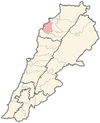Ras Maska
Ras Maska رَأْسُ مَسْقَا | |
|---|---|
City | |
| Coordinates: 34°23′0″N 35°50′0″E / 34.38333°N 35.83333°E | |
| Country | |
| Governorate | North Governorate |
| District | Koura District |
| Government | |
| Elevation | 150 m (490 ft) |
| Population | |
| • Total | 20,000 |
| Time zone | UTC+2 (EET) |
| • Summer (DST) | UTC+3 (EEST) |
| Dialing code | +961 |
Ras Maska (also Ra's Maska or Ras Masqa, Lebanese Arabic: Rāṣ Masʾa, written as "رَأْسُ مَسْقَا", Classical Arabic: رَأْسُ مَسْقًى, romanized: Raʾs Masqa, lit. 'Head/Top of a watering source',[1][2] Syriac: ܪܺܫܳܐ ܡܰܣܩܳܐ[3][4]) is a village located in the Koura District in the North Governorate of Lebanon.
Geography
[edit]This village is located in the Koura district on the hills overlooking the Mediterranean to the south of Tripoli. It is divided between the northern and southern regions.
Northern Ras Maska, is the lowest part of the village, located at 60 meters (200 ft) above sea level. The religious majority of the northern population is Sunni Muslim.[5] It hosts many coastal beach resorts. Northern Ras Maska is known for its olive agriculture.[6]
Southern Ras Maska is the highest part of the village, located at 200 meters (660 ft) above sea level. The religious majority is Christian, including Greek Orthodox and Maronites.[5]
Etymology and names
[edit]The name of the village is probably derived from the Aramaic language, ras meaning top and maska meaning drinking stream." The equivalent meaning could be the top of the stream. Due to the geography of the village, this translation is more likely correct than the equivalent Arabic translation: top of irrigation.[7]
History
[edit]Ras Maska first appears in the Ottoman census of 1519. It belonged to the Nahiyat Koura / Anfeh and was inhabited by 14 male adults (more than 15 years old), 80% of them being married.[8] If we adopt the estimation of the Historians[9]), the number of inhabitants of Ras Maska in 1519 would have been of 70 persons.
In the Ottoman census of 1571, the number of male adults was 26. The population of Ras Maska practically doubled over the period, growing on average by 12 per mil per year to be compared to a growth of the number of inhabitants in the Nahiyat of 6.7% per mil per year.[8]
In 1953, Ras Maska had a population of 251 living in 40 households.[10]
Landmarks
[edit]- Lebanese University - North Lebanon Campus
- Centre universitaire du Liban-Nord - Université Saint-Joseph
- HARIRI Canadian University - North Campus
- Hospital Albert Haykel
- Ras Maska Volley-Ball Club
- Ras Maska Rd. Today and Rd. Tomorrow
- Ras Maska Steel Bridge
- Ras Maska Red Bridge
- Ras Maska Square
- Tripoli Beton
- Perla
References
[edit]- ^ "معنى مسقى في قواميس ومعاجم اللغة العربية". www.arabdict.com. Retrieved 2022-09-22.
- ^ "معنى رأس في قواميس ومعاجم اللغة العربية". www.arabdict.com. Retrieved 2022-09-22.
- ^ "ܪܝܫܐ", Wiktionary, 2022-09-05, retrieved 2022-09-18
- ^ https://sedra.bethmardutho.org/api/word/%DC%A1%DC%B0%DC%A3%DC%A9%DC%90.html [bare URL]
- ^ a b "Municipal and ikhtiyariah elections in Northern Lebanon" (PDF). The Monthly. March 2010. p. 23. Archived from the original (PDF) on 3 June 2016. Retrieved 30 October 2016.
- ^ El Nabbout, Khaled (June 2007) - Geo-Visualization Tools for Participatory Urban Planning The Case of Tripoli, Lebanon - Ph.D. thesis - Technischen Universität Dresden - page 39 - Pdf document (Last access: 28, October 2007)
- ^ Moubarac, Youakim (1984), Pentalogie antiochienne / domaine Maronite, volume 2, Tome II, Editions Cenacle Libanais, Beirut, page 713. OCLC 62029897
- ^ a b Khalifeh, Issam (1995), Abhath Fi Tarikh Shamal Loubnan, Private Editor, Hadtoun, page 34.
- ^ Khalifeh, Issam (1995), Abhath Fi Tarikh Shamal Loubnan, Private Editor, Hadtoun, page 24.
- ^ Sawaya, Salah Michel (March 1953). Household Income and Expenditure in Al-Kura, Lebanon (PDF). Scholarworks (M.A.). Beirut, Lebanon: Economics Dept., American University of Beirut, Lebanon. hdl:10938/3411. Archived from the original (PDF) on 24 March 2023. Retrieved 2023-03-24.
External links
[edit]- Ras Masqa, Localiban
- (in French) Municipalité de Ras Maska
- (in French) Lycée Franco-Libanais Alphonse De Lamartine


 French
French Deutsch
Deutsch




